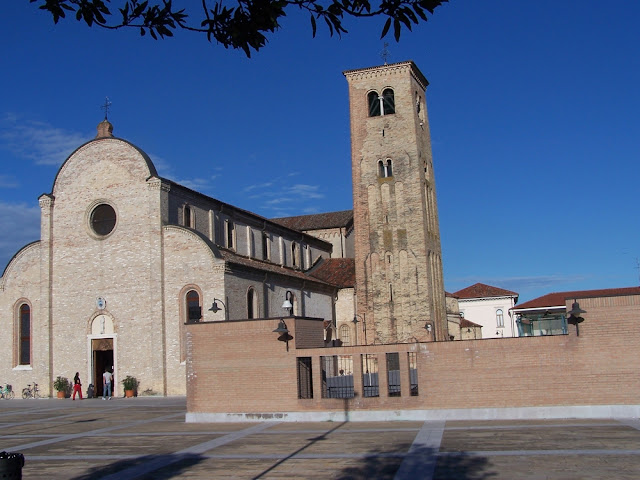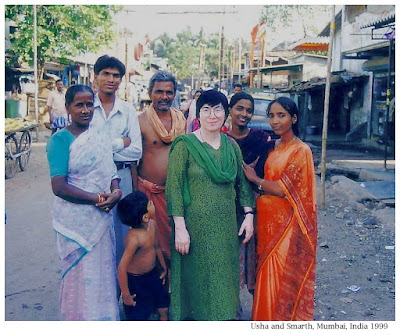I have always loved art ever since I can remember. As a child, I loved painting with water colours. In early 1990s, while living in Imola (Italy), I had done a short introductory course on oil paintings. At the same time, I love looking at art and knowing the artists.
This post is about a French artist called Philippe Charles Jacquet, whom I discovered some time ago and whose art-style I like very much. Apart from talking about Philippe Charles Jacquet and why I like his art, this post briefly touches on some other artists whose work I like. (Click on the images for a bigger view).jpg)
Philippe Charles Jacquet
Here is some information about Jacquet which I have gathered from internet:
Jacquet, born in Paris in 1953, studied architecture at the Ecole Nationale Supérieure des Arts Décoratifs. After working as an architect for about 20 years, in 2000 he decided to focus exclusively on painting. His background in architecture is reflected in his artwork in the symmetrical and geometric landscapes as well as in the way he sculpts rocks and designs houses. Brittany coasts and estuaries feature commonly in his works.What Captures Me in Jacquet's Works
I prefer traditional approaches to arts and I am not much of a fan of the concept art. Liking or not liking an artist's work can be very subjective - something which touches me very deeply, may leave you cold or indifferent, so I don't know if looking at Jacquet's works would affect you the way it does to me - I can look at his paintings literally for hours.
Jacquet's art calms me down and sometimes they draw me into a meditation-like trance. Looking at some of his paintings make me feel as if I am in a tunnel, going deep inside myself. Some of his works make me experience a kind of silence - I love books and words, and perhaps because of that, the voices in my head are always talking, thus, I love this experience of silence.
I love the colours he uses - a lot of pale colours, a lot of greens and blues and an occasional red. I like the early mornings or late evenings of his paintings where a lighted window, often with a vague presence of someone inside, calls me like a beacon. I like the pebbled surfaces underneath the water and along the sea-shores, and the thousands of blades of grass which seem to be moving in a gentle breeze. I like the boats anchored or floating gently on still water. I like the lonely figures standing still, lost in thought, waiting for something or someone. I like his lone bicycles moving along the edge of the water. And, I like the stairs cut into the rocks which come down towards the water.
There are some of his paintings which I wish I could have on a wall in my room, so that I can look at them when I fall asleep or when I wake up. However, I love the fact that I can find a lot of images of his paintings on internet, so that I can have them as backgrounds on the screens of my computer and tablet and I can keep on changing them.
So thank you Mr. Philippe Charles Jacquet for your wonderful magic realism and for giving me so much joy. I am glad that in 2000 you decided to follow your passion and devote full-time to paintings.
My Other Favourite Artists
Philippe Charles Jacquet is not the only artist whose works I like!
One of the first artist whose work I loved was B. Prabha, whose paintings of peasant-women and fisher-women with elongated bodies were published in the Hindi weekly Dharamyug during 1960s. I think that her art-style was somewhat inspired by the Mannerism school, which had developed in post-renaissance Europe in 16th and early 17th centuries. During renaissance, artists had developed techniques focusing on realistic representations of human bodies, ensuring life-like proportions and perspectives. In Mannerism, artists started to move away from realistic towards more emotional representations, giving rein to their imagination and fantasies. Perhaps, she was inspired by the works of Italian artist Amedeo Modigliani (1884-1920) who had used similar elongated bodies in some of his portraits.
Through my father, who was active in Socialist Party of India under Dr Ram Manohar Lohia, I had met some well-known Indian painters such as Makbool Fida Hussein and J. Swaminathan, whose works I used to like. I remember sitting as a child with Hussein saheb at India Coffee House in Connaught Place in Delhi in early 1960s, which was located in those days where today there is the underground Palika Bazar - at that time, it had the coffee house in the centre surrounded in a semi-circle by the different state emporiums in wooden buildings. I also remember walking towards Triveni Kala Sangam with Hussein saheb to see his exhibition and meeting Dr Zakir Hussein, who was then the vice-president of India. I also remember the dismay of all the socialist friends of my father a decade latter, when Hussein saheb had defined Ms. Indira Gandhi as Durga and painted a whole series of paintings on that theme.
In Europe, I have been absolutely smitten by the paintings of Caravaggio and the surrealism of Salvador Dalì, both of whom do not need any introduction and have enormous fan followings. At the same time, in more recent times, I like many lesser-known water colour painters, some of whom I follow on Instagram - I love to watch their Reels where they show the development of a painting.
In The End
I hope that through this post you can understand why I like the art of Philippe Charles Jacquet. If you also get a special feeling when you look at these, do share about it in the comments below.
I am passionate about water-colours but they don't affect me like the art of Mr Jacquet. I think that to be so affected by art is a gift, a special way of communication between me and the nature through its forms and colours.
***


.jpg)
.jpg)
.jpg)

.jpg)
.jpg)
.jpg)
.jpg)

.jpg)
.jpg)
.jpg)
.jpg)
.jpg)
.jpg)
.jpg)


.jpg)
.jpg)


.jpg)

.jpg)

























